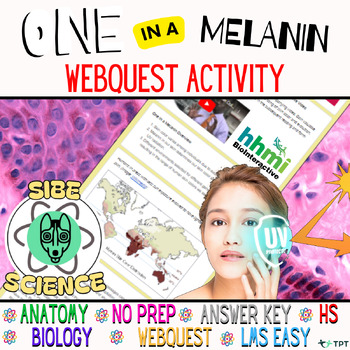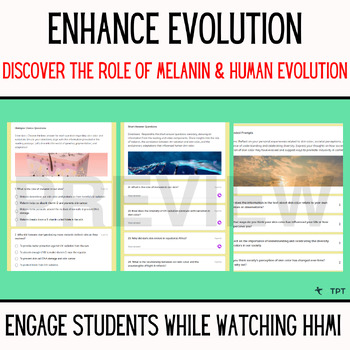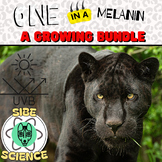Biology Webquest | Melanin | Science | Multicultural | Google Forms | Anatomy, 9
- Google Drive™ folder
- Internet Activities
- Webquests

Also included in
- Discover the fascinating world of melanin with our comprehensive bundle created to shed light on the significance of this crucial component in high school science education. An important topic in biology and anatomy standards, melanin a complex pigment that's responsible for skin color and protectioPrice $10.79Original Price $11.99Save $1.20
Description
✋️Introducing One In A Melanin: The Biology of Skin Color — HHMI BioInteractive Video Webquest, a comprehensive resource designed for grades 9-12. With a focus on inquiry-based learning, this resource encourages students to explore the biology of skin color dynamically and interactively. The resource includes a captivating reading passage, and an educational video component, and fosters thought-provoking discussions that will challenge your students' thinking. What sets this resource apart is its commitment to inclusivity, celebrating the beautiful spectrum of human skin colors. It comes in the form of a Google form with an auto-grading feature, providing streamlined assessment. Take your lessons to the next level and empower your students to grasp the complexities of skin color and evolution with this supercharged teaching resource.
✔️What's Inside:
- In-depth exploration of skin color and evolution with a comprehensive lesson plan.
- Google Form featuring a comprehensive exploration of skin color and evolution.
- Teacher Aid: Step-by-Step Guide for Using Google Forms and Making Copies.
- 35 Questions, 20 multiple-choice, 10 short answers, and 5 open-response questions. All are answered and set up for auto grade out of 100 points.
✔️What's the benefit:
Google Forms offers teachers time efficiency, easy customization, real-time feedback, and automated grading. For students, it provides a user-friendly interface, immediate feedback, flexibility, and access anytime, anywhere, and contributes to a paperless learning environment. The platform's versatility enhances efficiency and fosters an adaptive and engaging learning experience for both teachers and students.
⭐Hey teacher, you matter!
Your support is incredibly valuable to us! Here's a step-by-step guide on how you can earn TpT credits for greater rewards on your upcoming purchases:
1. Visit Your Purchase History:
- Log in to your TpT account and navigate to your Purchase History.
2. Discover the "Share Your Thoughts" Button:
- Next to each purchase, find the "Share Your Thoughts" button.
3. Express Your Feedback:
- Click on "Share Your Thoughts."
- Quickly rate the product and share a brief comment.
4. Accumulate TpT Credits:
- For every feedback you provide, TpT rewards you with credits.
- Collect and redeem these credits to enjoy discounts on your future purchases.
We appreciate your insights, as they guide us in creating valuable resources for your classroom. Thank you for being an integral part of our community!
⏳️Stay in the Loop for Exclusive Offers
- Be the first to know about our latest discounts, freebies, and product launches.
- Spot the unique icon next to our store logo and click to become a follower.
- Enjoy receiving email updates about exciting developments in our store.
Related Resources
❄Join the Sibe Science Community: For updates about sales, and new products, and to become part of our vibrant and growing science community, please feel free to follow my store: My TpT Store
⚖This [product/document/resource] may include materials subject to copyright or trademark protection. Including these materials is intended to fall within the principles of fair use under copyright law. The use is for educational purposes and is not intended to infringe upon the intellectual property rights of others.
All rights are respected, ensuring this product is for personal classroom use only. Redistribution or posting on websites or educational blogs, in part or its entirety, is strictly prohibited. © 2024 by Sibe Science






